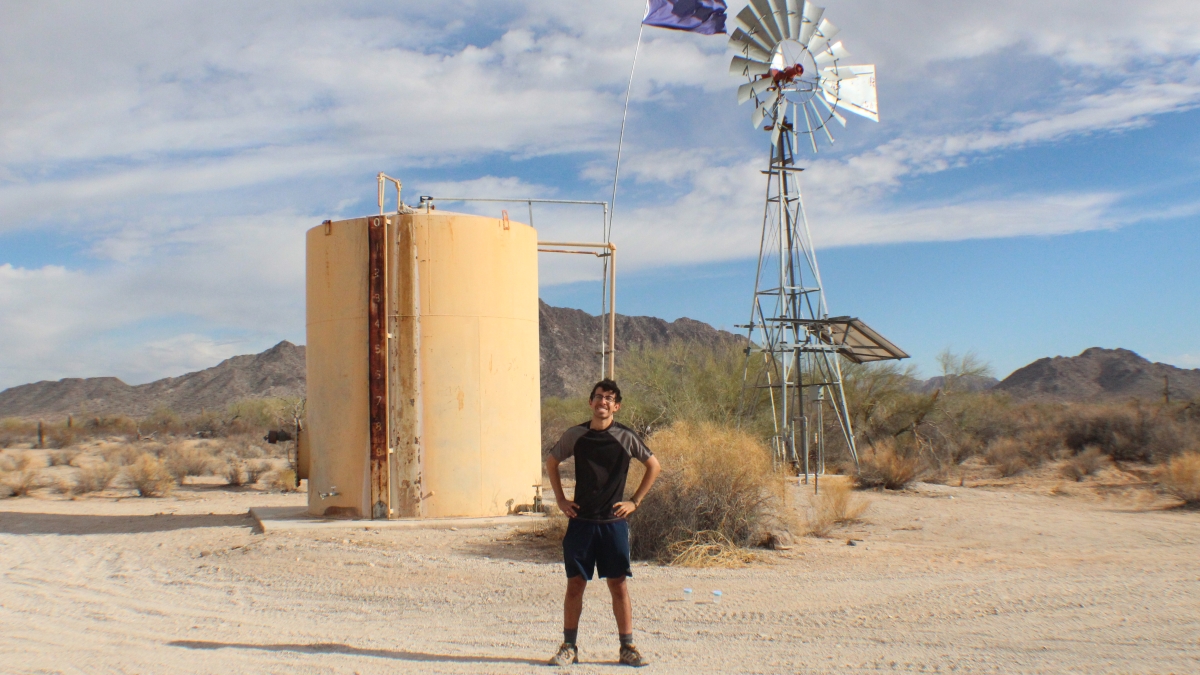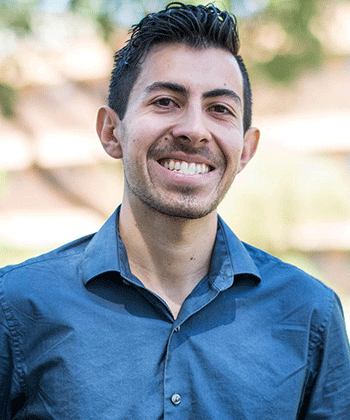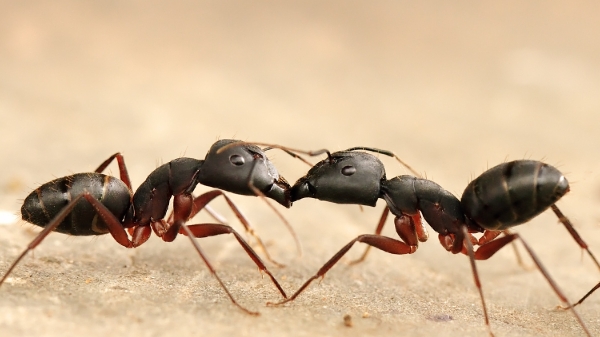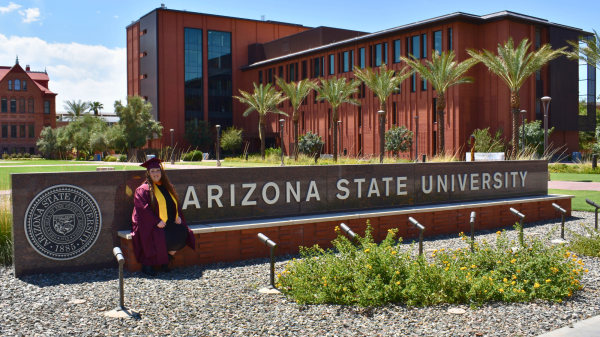Geography and urban planning graduate to use degrees for humanitarian efforts

Gabriel Leon at Papago Well, the halfway point on the Devil's Highway, an area of Arizona desert where he went on a two-week water research expedition in 2017.
Editor’s note: This is part of a series of profiles for spring 2018 commencement.
Gabriel Leon, who is graduating this semester from the School of Geographical Sciences and Urban Planning with a double major in geography and urban planning, used his interest in both the natural and built environments and the relationship between the two to help create an educational plan that is helping him to tackle issues that are close to his heart.
As a child, learning the state capitals came easy. On classroom quizzes, he would put in the extra effort to name the international capitals, too. But, ultimately, geography wasn’t Leon’s first choice for a college major.
A friend mentioned she’d added it as a second major, and when he looked into it and “found out that it included everything I had always been interested in: landscape evolution, transportation networks, plant ecology, cultural patterns, urban form, and mapping software,” he said. He switched majors the next day.
His interest in urban planning was piqued following time spent in Washington as part of the Doris Duke Conservation Scholars Program.
“I was jealous of the way natural space was respected and loved by Seattle folks,” said Leon, of Phoenix, “including the caring way urban waters were being revitalized, the cross-town bikeways, the downtown transit tunnel and the affordable housing initiatives. Why didn’t Phoenix have those things?”
He will graduate ASU in May with a bachelor’s in geography, a bachelor’s in planning, a geographic information science certificate and honors from Barrett, The Honors College. While at the university he won prestigious scholarships including the Mark Bowland Leadership Scholarship and the Matthew G. Bailey Scholarship.
Leon has moved to turning his education into action working to provide humanitarian aid in the U.S.-Mexico border region. His efforts, sparked in part by his coursework in geography, have brought him to provide clean water and medical care to migrants passing through the region. Through his course work, Leon learned not only about the issue of migrant deaths in the desert, but also how geography can be used to help address the issue.
As a student in Barrett, The Honors College, he received the Quesada Award, a scholarship that helps fund honors theses focusing on issues affecting the Hispanic community. Leon used the award for his thesis titled “Humanitarian Aid in the Borderlands: A Geographical Exploration of Water Sources in Cabeza Prieta National Wildlife Refuge.”

Gabriel Leon will graduate in May with a double major in geography and urban planning.
Quesada funds covered gas, food, medical supplies and training for on-the-ground research of the region, located in southwestern Arizona along the U.S.-Mexico border. Leon took a 10-day research trip to the area, one of many visits where he combined thesis research with humanitarian aid work.
He surveyed the location and quality of dozens of existing water sources in the Cabeza Prieta. The aim of his survey was to determine the relationship between human-remains recovery sites and water sources, information that humanitarian aid organizations could use to determine how and where to deploy assistance.
“Documenting a landscape over 13,000 square miles for search-and-rescue/recovery of lost and deceased migrants has been a daunting challenge, and there's still so much left to do,” he said.
“With more than 3,000 confirmed migrant deaths and somewhere between 9,000 and 15,000 estimated migrant deaths on the Arizona-Mexico border, it is critical to understand the region and be able to respond adequately to the humanitarian crisis.”
After graduation, Leon plans to move to Tucson to continue his humanitarian work at the border where he hopes to use his thesis research to help construct a search-and-rescue guide for missing migrants. He now is logistics director for No More Deaths/No Mas Muertes, a Southern Arizona-based organization that provides humanitarian aid to migrants and which is a ministry of the Unitarian Universalist Church of Tucson.
Leon will be recognized for his scholastic achievements and volunteer work by being named a Dean's Medal recipient for the 2018 spring semester.
Question: What was your “aha” moment, when you realized you wanted to study the field you majored in?
Answer: I know this is the opposite of what I’m supposed to say, but it started by learning all the state capitals as a kid. I memorized them before anyone else, and then on the quiz listed all the international capitals on the back of the paper to show off.
I ended up finding the geography major by accident, when a friend of mine told me she had added it as a second major. Curious, I did some research, and found out that it included everything I had always been interested in: landscape evolution, transportation networks, plant ecology, cultural patterns, urban form, and mapping software. I went to an adviser the next day and switched to geography; the rest is history. Geography really is a catch-all to explore the world and lets you dabble in absolutely everything. I can’t imagine what my college experience would have been like if I never found it.
Q: What’s something you learned while at ASU — in the classroom or otherwise — that surprised you, that changed your perspective?
A: Getting involved with humanitarian aid work on the border has changed my life. It started with a field course taught by Dr. Scott Warren regarding the geography of the West Desert, a huge swath of land between Yuma and Phoenix, the ancestral lands of the Hia C-ed O’odham (Native American peoples whose traditional homeland lies between the Ajo Range, the Gila River, the Colorado River and the Gulf of California). The course taught us how to be ethical researchers who actively participate in what they study. I learned in depth about the crisis of migrant deaths in the Arizona desert and the different ways that geography can be applied to alleviate it.
I stayed involved with the human rights organizations we partnered with after the class finished, and before I knew it I was one of the main organizers for humanitarian aid in the region. It’s been two years now, and I’m still leading and navigating trips to Organ Pipe National Monument and the surrounding land to leave water and offer medical aid to folks crossing. I am gaining a drastically different understanding of migration and border politics, but I also have learned the hard way what effectively organizing does and does not look like, as well as how to compartmentalize the secondhand trauma of finding human remains every weekend.
Q: What’s the best piece of advice you’d give to those still in school?
A: Get super involved with a club or an organization if you have the ability to. The more involved you are with a group of people doing similar things, the more motivated you are as a student and a changemaker. A little bit of passion and community goes a long way.
Q: What was your favorite spot on campus, whether for studying, meeting friends or just thinking about life?
A: I absolutely love the Farmer Education Building. I think it’s a great example of midcentury modern architecture, and the tropical aesthetics of the shaded courtyard contrast nicely with the brutalist concrete exterior. I write my best essays and make my best memes there. I also may or may not enjoy sitting in the fountain with friends on hot September evenings. On a more serious note, though, as Phoenix becomes more urban in the coming years, I think that Farmer can act as an example for sustainable desert architecture that reflects a unique identity for our city.
Q: What are your plans after graduation?
A: I’m moving to Tucson for the summer to do humanitarian aid work on the border full time, because that’s when volunteers are needed the most, but the fewest are around. Additionally, I’ll be using my thesis research to help construct a search-and-rescue guide for missing migrants. After that, I’ll do some trail work with AmeriCorps, spend some time tidying up my Spanish, go abroad for a while, and then off to grad school at some point to get my master’s in transportation planning and/or landscape architecture. I haven’t exactly decided yet.
In the long run, I intend to boomerang back to Phoenix because that’s where my heart is. I really want to reconnect the city with our natural water sources and improve our public transportation networks. I’d like to see the Salt River flowing, bounded by cottonwood trees and affordable housing, and I want to see Union Station come alive again as a bustling hub for commuter rail.
Q: If someone gave you $40 million to solve one problem on our planet, what would you tackle?
A: I would put it toward assisting undocumented folks with legal expenses. It’s an issue that hits close to home to me, since my family came to the United States without papers, and because so many people I love worry about being able to stay in the country where they’ve built their lives. We have an outdated immigration system that lets in too few people and is too stingy with citizenship.
The legal costs associated with immigration are so high that they act as a barrier preventing low-income immigrants from coming to the U.S. via the designated process. Doing human rights work on the border and seeing people die because of the lack of safe, legal and affordable pathways toward residency and citizenship has made me realize just how severe the problem is. $40 million would be a drop in the bucket compared to what is needed, but it would be a start.
Written by Megan Martin and Nicole Greason
More Sun Devil community

Army veteran dedicates PhD to exploring the social order of ant colonies
While Colin Lynch was enlisted as a medic in the National Guard, he had a pastime that was quite different from that of his peers…
College of Health Solutions grad, soccer star hopes to make the big leagues
A staple lineup defender on the Sun Devil women’s soccer team, Lauren Kirberg is looking to join the National Women’s Soccer…

ASU grad finds her calling in advocating for people through clinical research
Rhiannon Elliott-McGaugh-Mask grew up hundreds of miles away from an ocean, but that wasn’t an issue when deciding her future…